Assignment 1: Literature Review on Social Electronic Commerce Analysis
VerifiedAdded on 2021/06/17
|15
|3537
|40
Literature Review
AI Summary
This literature review examines the concept of social electronic commerce, exploring its definition, types (onsite and offsite), elements (reciprocity, community, authority, scarcity), and features. The review highlights the benefits for businesses, including higher search engine rankings, consistent audience growth, authentic engagement, and customer loyalty. It also addresses the problems, such as negative comments and brand image issues. The scope includes the application of social e-commerce for both large and small organizations. The review analyzes existing literature to identify trends and gaps, concluding with a summary of the key findings. The review discusses the concept of social e-commerce, its elements, features and how businesses can benefit from it. It also discusses the problems associated with it and recent trends. The review aims to help marketing managers to understand the theoretical ideas of social e-commerce.

Running head: ASSIGNMENT 1: LITERATURE REVIEW
Assignment 1
Literature Review
Opportunities and problems of Social Electronic Commerce
Student’s name:
Name of the university:
Author’s note:
Assignment 1
Literature Review
Opportunities and problems of Social Electronic Commerce
Student’s name:
Name of the university:
Author’s note:
Paraphrase This Document
Need a fresh take? Get an instant paraphrase of this document with our AI Paraphraser
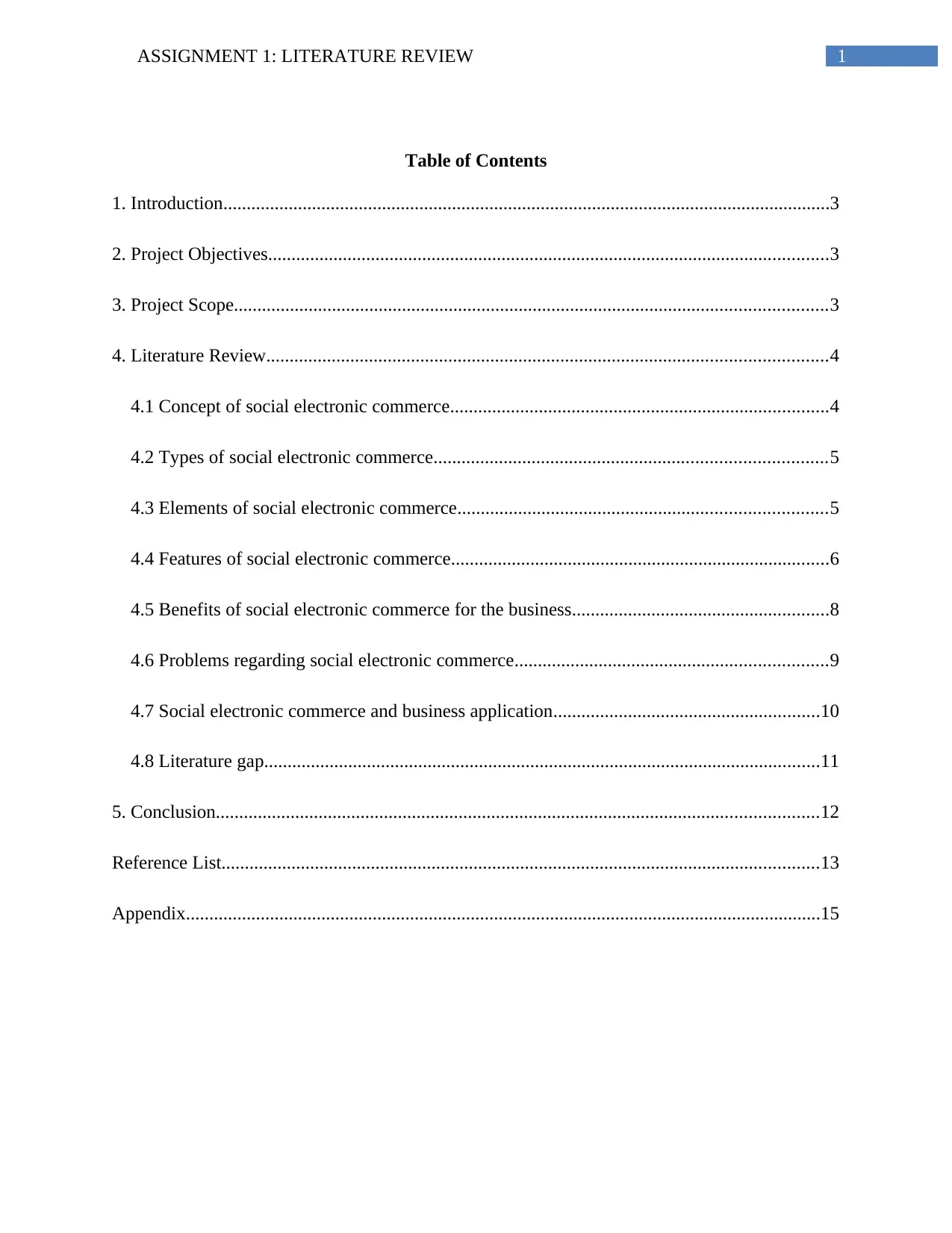
1ASSIGNMENT 1: LITERATURE REVIEW
Table of Contents
1. Introduction..................................................................................................................................3
2. Project Objectives........................................................................................................................3
3. Project Scope...............................................................................................................................3
4. Literature Review........................................................................................................................4
4.1 Concept of social electronic commerce.................................................................................4
4.2 Types of social electronic commerce....................................................................................5
4.3 Elements of social electronic commerce...............................................................................5
4.4 Features of social electronic commerce.................................................................................6
4.5 Benefits of social electronic commerce for the business.......................................................8
4.6 Problems regarding social electronic commerce...................................................................9
4.7 Social electronic commerce and business application.........................................................10
4.8 Literature gap.......................................................................................................................11
5. Conclusion.................................................................................................................................12
Reference List................................................................................................................................13
Appendix........................................................................................................................................15
Table of Contents
1. Introduction..................................................................................................................................3
2. Project Objectives........................................................................................................................3
3. Project Scope...............................................................................................................................3
4. Literature Review........................................................................................................................4
4.1 Concept of social electronic commerce.................................................................................4
4.2 Types of social electronic commerce....................................................................................5
4.3 Elements of social electronic commerce...............................................................................5
4.4 Features of social electronic commerce.................................................................................6
4.5 Benefits of social electronic commerce for the business.......................................................8
4.6 Problems regarding social electronic commerce...................................................................9
4.7 Social electronic commerce and business application.........................................................10
4.8 Literature gap.......................................................................................................................11
5. Conclusion.................................................................................................................................12
Reference List................................................................................................................................13
Appendix........................................................................................................................................15
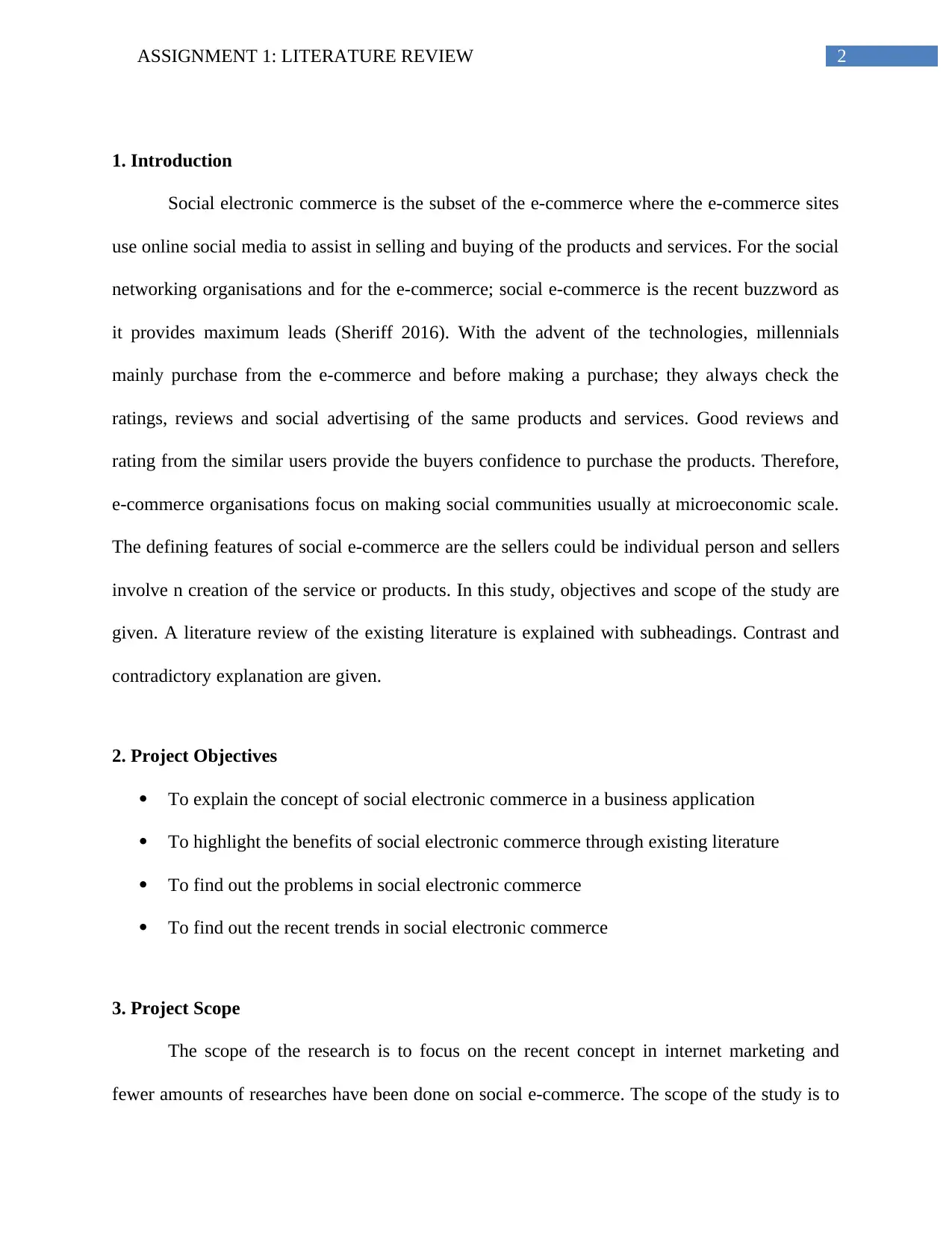
2ASSIGNMENT 1: LITERATURE REVIEW
1. Introduction
Social electronic commerce is the subset of the e-commerce where the e-commerce sites
use online social media to assist in selling and buying of the products and services. For the social
networking organisations and for the e-commerce; social e-commerce is the recent buzzword as
it provides maximum leads (Sheriff 2016). With the advent of the technologies, millennials
mainly purchase from the e-commerce and before making a purchase; they always check the
ratings, reviews and social advertising of the same products and services. Good reviews and
rating from the similar users provide the buyers confidence to purchase the products. Therefore,
e-commerce organisations focus on making social communities usually at microeconomic scale.
The defining features of social e-commerce are the sellers could be individual person and sellers
involve n creation of the service or products. In this study, objectives and scope of the study are
given. A literature review of the existing literature is explained with subheadings. Contrast and
contradictory explanation are given.
2. Project Objectives
To explain the concept of social electronic commerce in a business application
To highlight the benefits of social electronic commerce through existing literature
To find out the problems in social electronic commerce
To find out the recent trends in social electronic commerce
3. Project Scope
The scope of the research is to focus on the recent concept in internet marketing and
fewer amounts of researches have been done on social e-commerce. The scope of the study is to
1. Introduction
Social electronic commerce is the subset of the e-commerce where the e-commerce sites
use online social media to assist in selling and buying of the products and services. For the social
networking organisations and for the e-commerce; social e-commerce is the recent buzzword as
it provides maximum leads (Sheriff 2016). With the advent of the technologies, millennials
mainly purchase from the e-commerce and before making a purchase; they always check the
ratings, reviews and social advertising of the same products and services. Good reviews and
rating from the similar users provide the buyers confidence to purchase the products. Therefore,
e-commerce organisations focus on making social communities usually at microeconomic scale.
The defining features of social e-commerce are the sellers could be individual person and sellers
involve n creation of the service or products. In this study, objectives and scope of the study are
given. A literature review of the existing literature is explained with subheadings. Contrast and
contradictory explanation are given.
2. Project Objectives
To explain the concept of social electronic commerce in a business application
To highlight the benefits of social electronic commerce through existing literature
To find out the problems in social electronic commerce
To find out the recent trends in social electronic commerce
3. Project Scope
The scope of the research is to focus on the recent concept in internet marketing and
fewer amounts of researches have been done on social e-commerce. The scope of the study is to
⊘ This is a preview!⊘
Do you want full access?
Subscribe today to unlock all pages.

Trusted by 1+ million students worldwide
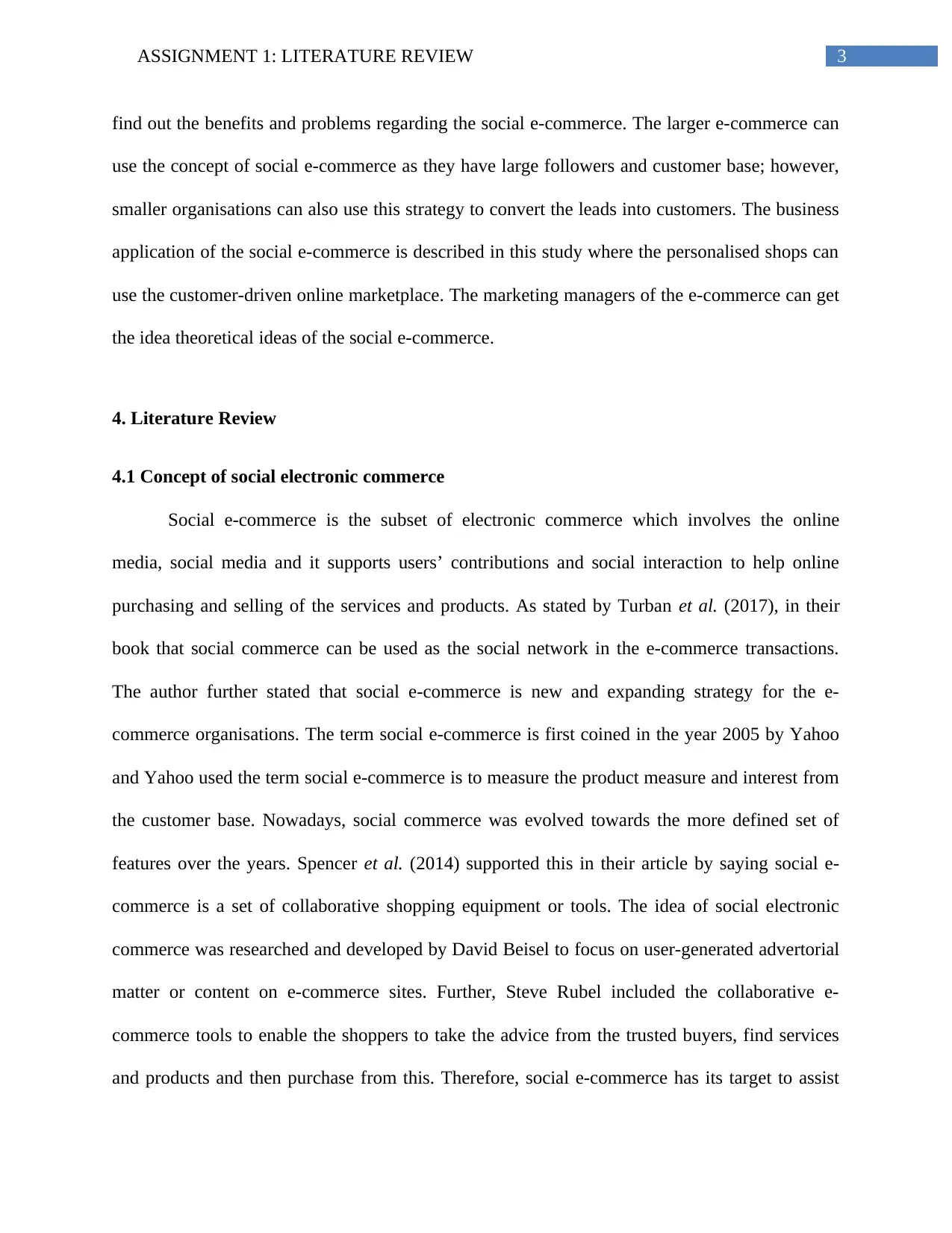
3ASSIGNMENT 1: LITERATURE REVIEW
find out the benefits and problems regarding the social e-commerce. The larger e-commerce can
use the concept of social e-commerce as they have large followers and customer base; however,
smaller organisations can also use this strategy to convert the leads into customers. The business
application of the social e-commerce is described in this study where the personalised shops can
use the customer-driven online marketplace. The marketing managers of the e-commerce can get
the idea theoretical ideas of the social e-commerce.
4. Literature Review
4.1 Concept of social electronic commerce
Social e-commerce is the subset of electronic commerce which involves the online
media, social media and it supports users’ contributions and social interaction to help online
purchasing and selling of the services and products. As stated by Turban et al. (2017), in their
book that social commerce can be used as the social network in the e-commerce transactions.
The author further stated that social e-commerce is new and expanding strategy for the e-
commerce organisations. The term social e-commerce is first coined in the year 2005 by Yahoo
and Yahoo used the term social e-commerce is to measure the product measure and interest from
the customer base. Nowadays, social commerce was evolved towards the more defined set of
features over the years. Spencer et al. (2014) supported this in their article by saying social e-
commerce is a set of collaborative shopping equipment or tools. The idea of social electronic
commerce was researched and developed by David Beisel to focus on user-generated advertorial
matter or content on e-commerce sites. Further, Steve Rubel included the collaborative e-
commerce tools to enable the shoppers to take the advice from the trusted buyers, find services
and products and then purchase from this. Therefore, social e-commerce has its target to assist
find out the benefits and problems regarding the social e-commerce. The larger e-commerce can
use the concept of social e-commerce as they have large followers and customer base; however,
smaller organisations can also use this strategy to convert the leads into customers. The business
application of the social e-commerce is described in this study where the personalised shops can
use the customer-driven online marketplace. The marketing managers of the e-commerce can get
the idea theoretical ideas of the social e-commerce.
4. Literature Review
4.1 Concept of social electronic commerce
Social e-commerce is the subset of electronic commerce which involves the online
media, social media and it supports users’ contributions and social interaction to help online
purchasing and selling of the services and products. As stated by Turban et al. (2017), in their
book that social commerce can be used as the social network in the e-commerce transactions.
The author further stated that social e-commerce is new and expanding strategy for the e-
commerce organisations. The term social e-commerce is first coined in the year 2005 by Yahoo
and Yahoo used the term social e-commerce is to measure the product measure and interest from
the customer base. Nowadays, social commerce was evolved towards the more defined set of
features over the years. Spencer et al. (2014) supported this in their article by saying social e-
commerce is a set of collaborative shopping equipment or tools. The idea of social electronic
commerce was researched and developed by David Beisel to focus on user-generated advertorial
matter or content on e-commerce sites. Further, Steve Rubel included the collaborative e-
commerce tools to enable the shoppers to take the advice from the trusted buyers, find services
and products and then purchase from this. Therefore, social e-commerce has its target to assist
Paraphrase This Document
Need a fresh take? Get an instant paraphrase of this document with our AI Paraphraser
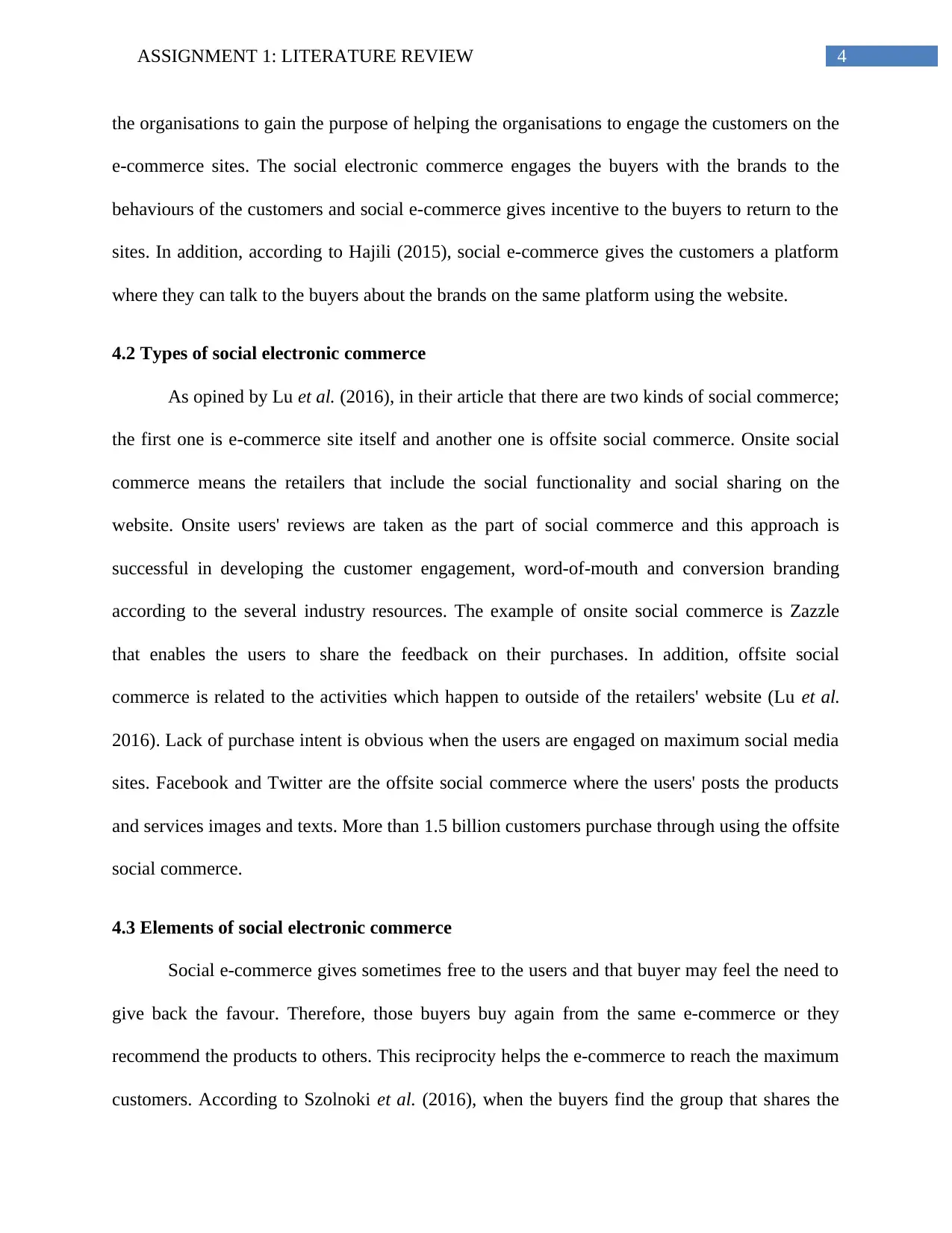
4ASSIGNMENT 1: LITERATURE REVIEW
the organisations to gain the purpose of helping the organisations to engage the customers on the
e-commerce sites. The social electronic commerce engages the buyers with the brands to the
behaviours of the customers and social e-commerce gives incentive to the buyers to return to the
sites. In addition, according to Hajili (2015), social e-commerce gives the customers a platform
where they can talk to the buyers about the brands on the same platform using the website.
4.2 Types of social electronic commerce
As opined by Lu et al. (2016), in their article that there are two kinds of social commerce;
the first one is e-commerce site itself and another one is offsite social commerce. Onsite social
commerce means the retailers that include the social functionality and social sharing on the
website. Onsite users' reviews are taken as the part of social commerce and this approach is
successful in developing the customer engagement, word-of-mouth and conversion branding
according to the several industry resources. The example of onsite social commerce is Zazzle
that enables the users to share the feedback on their purchases. In addition, offsite social
commerce is related to the activities which happen to outside of the retailers' website (Lu et al.
2016). Lack of purchase intent is obvious when the users are engaged on maximum social media
sites. Facebook and Twitter are the offsite social commerce where the users' posts the products
and services images and texts. More than 1.5 billion customers purchase through using the offsite
social commerce.
4.3 Elements of social electronic commerce
Social e-commerce gives sometimes free to the users and that buyer may feel the need to
give back the favour. Therefore, those buyers buy again from the same e-commerce or they
recommend the products to others. This reciprocity helps the e-commerce to reach the maximum
customers. According to Szolnoki et al. (2016), when the buyers find the group that shares the
the organisations to gain the purpose of helping the organisations to engage the customers on the
e-commerce sites. The social electronic commerce engages the buyers with the brands to the
behaviours of the customers and social e-commerce gives incentive to the buyers to return to the
sites. In addition, according to Hajili (2015), social e-commerce gives the customers a platform
where they can talk to the buyers about the brands on the same platform using the website.
4.2 Types of social electronic commerce
As opined by Lu et al. (2016), in their article that there are two kinds of social commerce;
the first one is e-commerce site itself and another one is offsite social commerce. Onsite social
commerce means the retailers that include the social functionality and social sharing on the
website. Onsite users' reviews are taken as the part of social commerce and this approach is
successful in developing the customer engagement, word-of-mouth and conversion branding
according to the several industry resources. The example of onsite social commerce is Zazzle
that enables the users to share the feedback on their purchases. In addition, offsite social
commerce is related to the activities which happen to outside of the retailers' website (Lu et al.
2016). Lack of purchase intent is obvious when the users are engaged on maximum social media
sites. Facebook and Twitter are the offsite social commerce where the users' posts the products
and services images and texts. More than 1.5 billion customers purchase through using the offsite
social commerce.
4.3 Elements of social electronic commerce
Social e-commerce gives sometimes free to the users and that buyer may feel the need to
give back the favour. Therefore, those buyers buy again from the same e-commerce or they
recommend the products to others. This reciprocity helps the e-commerce to reach the maximum
customers. According to Szolnoki et al. (2016), when the buyers find the group that shares the
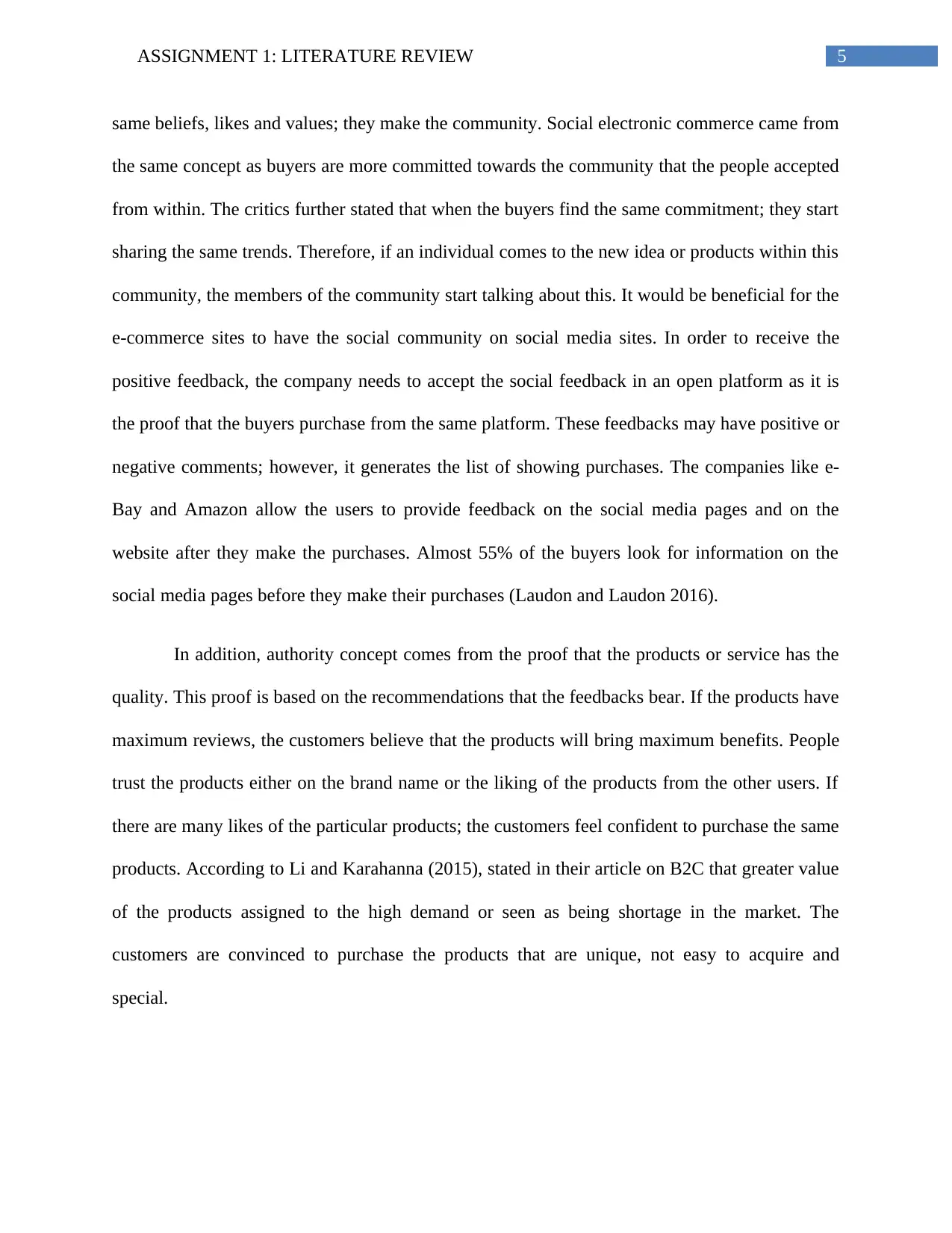
5ASSIGNMENT 1: LITERATURE REVIEW
same beliefs, likes and values; they make the community. Social electronic commerce came from
the same concept as buyers are more committed towards the community that the people accepted
from within. The critics further stated that when the buyers find the same commitment; they start
sharing the same trends. Therefore, if an individual comes to the new idea or products within this
community, the members of the community start talking about this. It would be beneficial for the
e-commerce sites to have the social community on social media sites. In order to receive the
positive feedback, the company needs to accept the social feedback in an open platform as it is
the proof that the buyers purchase from the same platform. These feedbacks may have positive or
negative comments; however, it generates the list of showing purchases. The companies like e-
Bay and Amazon allow the users to provide feedback on the social media pages and on the
website after they make the purchases. Almost 55% of the buyers look for information on the
social media pages before they make their purchases (Laudon and Laudon 2016).
In addition, authority concept comes from the proof that the products or service has the
quality. This proof is based on the recommendations that the feedbacks bear. If the products have
maximum reviews, the customers believe that the products will bring maximum benefits. People
trust the products either on the brand name or the liking of the products from the other users. If
there are many likes of the particular products; the customers feel confident to purchase the same
products. According to Li and Karahanna (2015), stated in their article on B2C that greater value
of the products assigned to the high demand or seen as being shortage in the market. The
customers are convinced to purchase the products that are unique, not easy to acquire and
special.
same beliefs, likes and values; they make the community. Social electronic commerce came from
the same concept as buyers are more committed towards the community that the people accepted
from within. The critics further stated that when the buyers find the same commitment; they start
sharing the same trends. Therefore, if an individual comes to the new idea or products within this
community, the members of the community start talking about this. It would be beneficial for the
e-commerce sites to have the social community on social media sites. In order to receive the
positive feedback, the company needs to accept the social feedback in an open platform as it is
the proof that the buyers purchase from the same platform. These feedbacks may have positive or
negative comments; however, it generates the list of showing purchases. The companies like e-
Bay and Amazon allow the users to provide feedback on the social media pages and on the
website after they make the purchases. Almost 55% of the buyers look for information on the
social media pages before they make their purchases (Laudon and Laudon 2016).
In addition, authority concept comes from the proof that the products or service has the
quality. This proof is based on the recommendations that the feedbacks bear. If the products have
maximum reviews, the customers believe that the products will bring maximum benefits. People
trust the products either on the brand name or the liking of the products from the other users. If
there are many likes of the particular products; the customers feel confident to purchase the same
products. According to Li and Karahanna (2015), stated in their article on B2C that greater value
of the products assigned to the high demand or seen as being shortage in the market. The
customers are convinced to purchase the products that are unique, not easy to acquire and
special.
⊘ This is a preview!⊘
Do you want full access?
Subscribe today to unlock all pages.

Trusted by 1+ million students worldwide
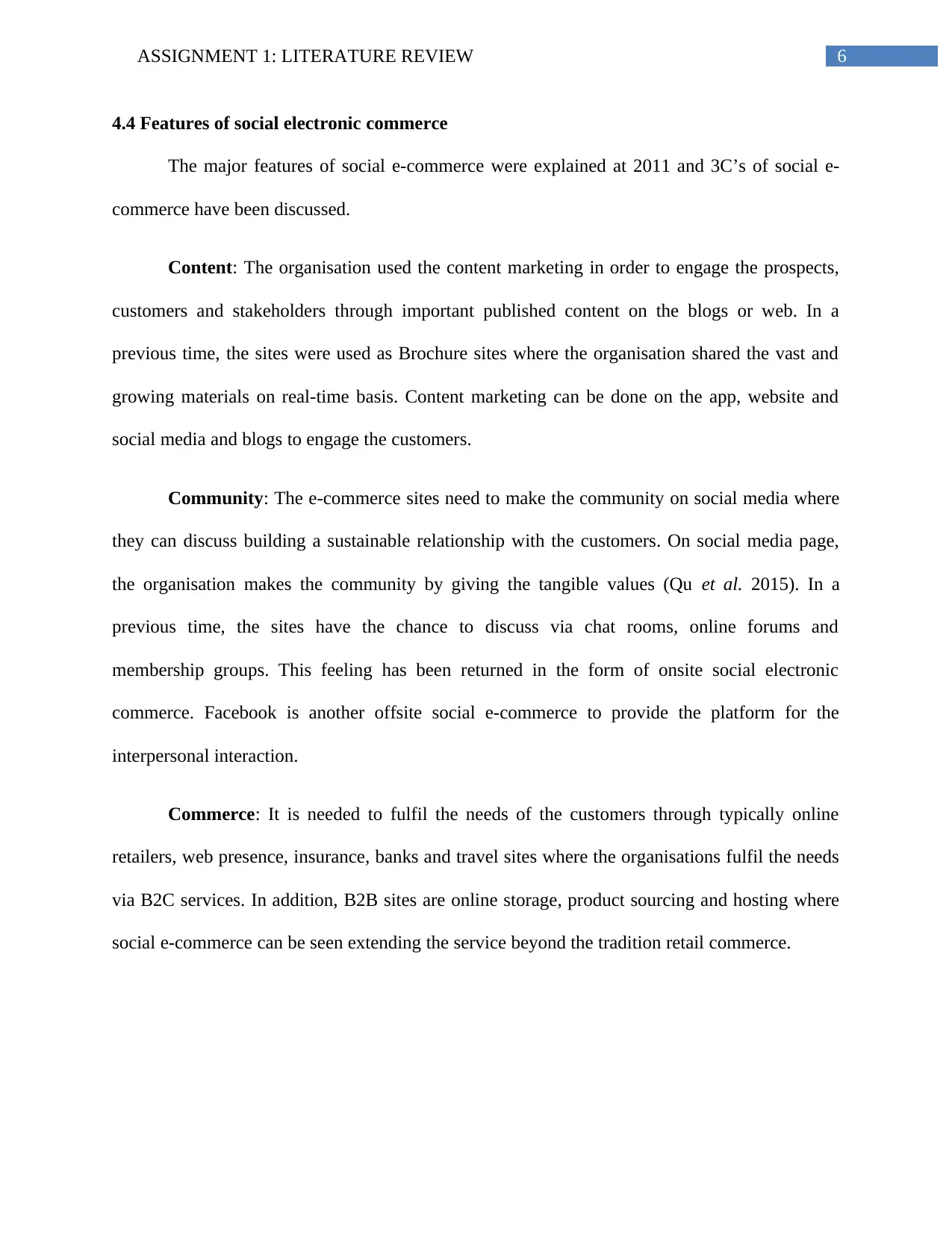
6ASSIGNMENT 1: LITERATURE REVIEW
4.4 Features of social electronic commerce
The major features of social e-commerce were explained at 2011 and 3C’s of social e-
commerce have been discussed.
Content: The organisation used the content marketing in order to engage the prospects,
customers and stakeholders through important published content on the blogs or web. In a
previous time, the sites were used as Brochure sites where the organisation shared the vast and
growing materials on real-time basis. Content marketing can be done on the app, website and
social media and blogs to engage the customers.
Community: The e-commerce sites need to make the community on social media where
they can discuss building a sustainable relationship with the customers. On social media page,
the organisation makes the community by giving the tangible values (Qu et al. 2015). In a
previous time, the sites have the chance to discuss via chat rooms, online forums and
membership groups. This feeling has been returned in the form of onsite social electronic
commerce. Facebook is another offsite social e-commerce to provide the platform for the
interpersonal interaction.
Commerce: It is needed to fulfil the needs of the customers through typically online
retailers, web presence, insurance, banks and travel sites where the organisations fulfil the needs
via B2C services. In addition, B2B sites are online storage, product sourcing and hosting where
social e-commerce can be seen extending the service beyond the tradition retail commerce.
4.4 Features of social electronic commerce
The major features of social e-commerce were explained at 2011 and 3C’s of social e-
commerce have been discussed.
Content: The organisation used the content marketing in order to engage the prospects,
customers and stakeholders through important published content on the blogs or web. In a
previous time, the sites were used as Brochure sites where the organisation shared the vast and
growing materials on real-time basis. Content marketing can be done on the app, website and
social media and blogs to engage the customers.
Community: The e-commerce sites need to make the community on social media where
they can discuss building a sustainable relationship with the customers. On social media page,
the organisation makes the community by giving the tangible values (Qu et al. 2015). In a
previous time, the sites have the chance to discuss via chat rooms, online forums and
membership groups. This feeling has been returned in the form of onsite social electronic
commerce. Facebook is another offsite social e-commerce to provide the platform for the
interpersonal interaction.
Commerce: It is needed to fulfil the needs of the customers through typically online
retailers, web presence, insurance, banks and travel sites where the organisations fulfil the needs
via B2C services. In addition, B2B sites are online storage, product sourcing and hosting where
social e-commerce can be seen extending the service beyond the tradition retail commerce.
Paraphrase This Document
Need a fresh take? Get an instant paraphrase of this document with our AI Paraphraser
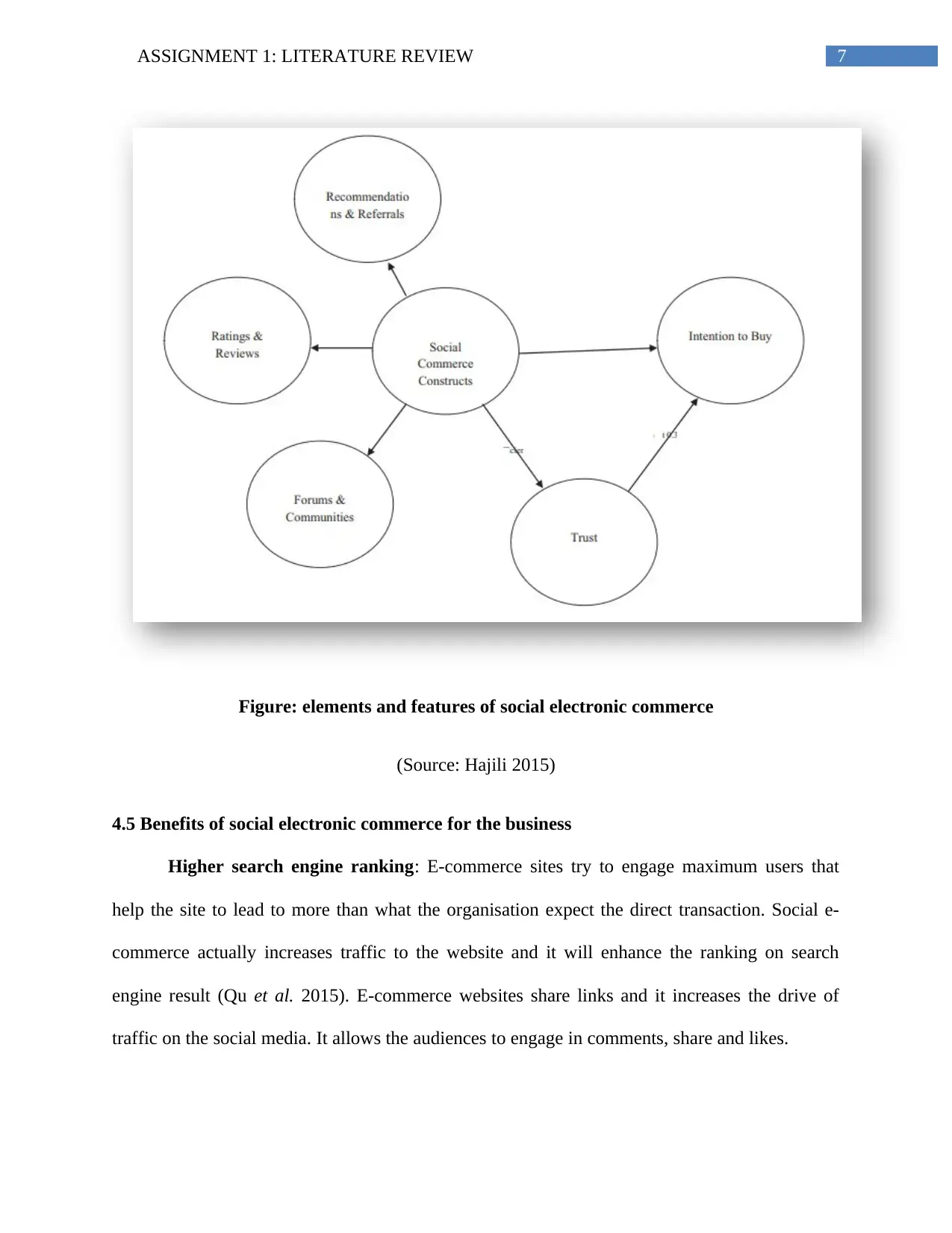
7ASSIGNMENT 1: LITERATURE REVIEW
Figure: elements and features of social electronic commerce
(Source: Hajili 2015)
4.5 Benefits of social electronic commerce for the business
Higher search engine ranking: E-commerce sites try to engage maximum users that
help the site to lead to more than what the organisation expect the direct transaction. Social e-
commerce actually increases traffic to the website and it will enhance the ranking on search
engine result (Qu et al. 2015). E-commerce websites share links and it increases the drive of
traffic on the social media. It allows the audiences to engage in comments, share and likes.
Figure: elements and features of social electronic commerce
(Source: Hajili 2015)
4.5 Benefits of social electronic commerce for the business
Higher search engine ranking: E-commerce sites try to engage maximum users that
help the site to lead to more than what the organisation expect the direct transaction. Social e-
commerce actually increases traffic to the website and it will enhance the ranking on search
engine result (Qu et al. 2015). E-commerce websites share links and it increases the drive of
traffic on the social media. It allows the audiences to engage in comments, share and likes.
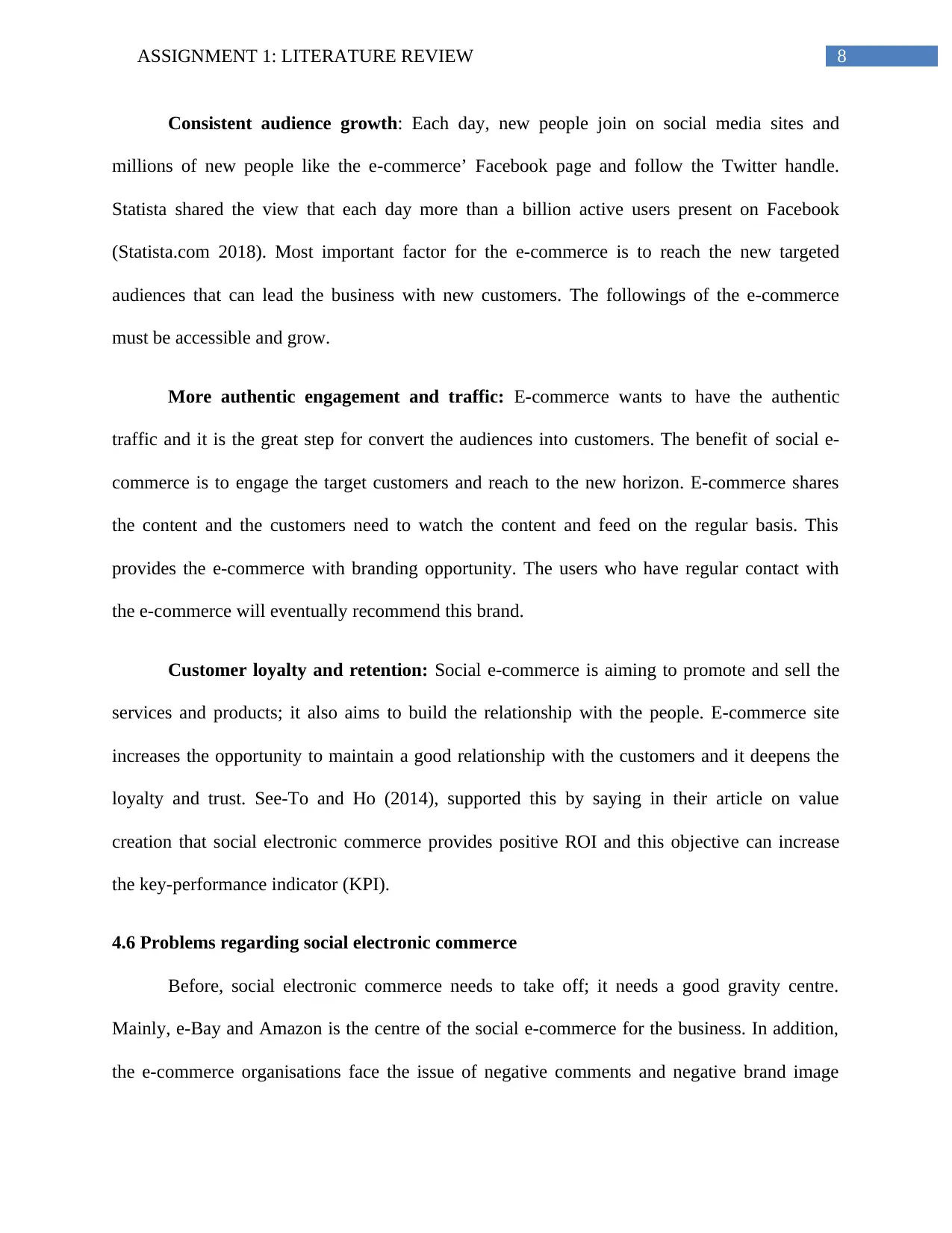
8ASSIGNMENT 1: LITERATURE REVIEW
Consistent audience growth: Each day, new people join on social media sites and
millions of new people like the e-commerce’ Facebook page and follow the Twitter handle.
Statista shared the view that each day more than a billion active users present on Facebook
(Statista.com 2018). Most important factor for the e-commerce is to reach the new targeted
audiences that can lead the business with new customers. The followings of the e-commerce
must be accessible and grow.
More authentic engagement and traffic: E-commerce wants to have the authentic
traffic and it is the great step for convert the audiences into customers. The benefit of social e-
commerce is to engage the target customers and reach to the new horizon. E-commerce shares
the content and the customers need to watch the content and feed on the regular basis. This
provides the e-commerce with branding opportunity. The users who have regular contact with
the e-commerce will eventually recommend this brand.
Customer loyalty and retention: Social e-commerce is aiming to promote and sell the
services and products; it also aims to build the relationship with the people. E-commerce site
increases the opportunity to maintain a good relationship with the customers and it deepens the
loyalty and trust. See-To and Ho (2014), supported this by saying in their article on value
creation that social electronic commerce provides positive ROI and this objective can increase
the key-performance indicator (KPI).
4.6 Problems regarding social electronic commerce
Before, social electronic commerce needs to take off; it needs a good gravity centre.
Mainly, e-Bay and Amazon is the centre of the social e-commerce for the business. In addition,
the e-commerce organisations face the issue of negative comments and negative brand image
Consistent audience growth: Each day, new people join on social media sites and
millions of new people like the e-commerce’ Facebook page and follow the Twitter handle.
Statista shared the view that each day more than a billion active users present on Facebook
(Statista.com 2018). Most important factor for the e-commerce is to reach the new targeted
audiences that can lead the business with new customers. The followings of the e-commerce
must be accessible and grow.
More authentic engagement and traffic: E-commerce wants to have the authentic
traffic and it is the great step for convert the audiences into customers. The benefit of social e-
commerce is to engage the target customers and reach to the new horizon. E-commerce shares
the content and the customers need to watch the content and feed on the regular basis. This
provides the e-commerce with branding opportunity. The users who have regular contact with
the e-commerce will eventually recommend this brand.
Customer loyalty and retention: Social e-commerce is aiming to promote and sell the
services and products; it also aims to build the relationship with the people. E-commerce site
increases the opportunity to maintain a good relationship with the customers and it deepens the
loyalty and trust. See-To and Ho (2014), supported this by saying in their article on value
creation that social electronic commerce provides positive ROI and this objective can increase
the key-performance indicator (KPI).
4.6 Problems regarding social electronic commerce
Before, social electronic commerce needs to take off; it needs a good gravity centre.
Mainly, e-Bay and Amazon is the centre of the social e-commerce for the business. In addition,
the e-commerce organisations face the issue of negative comments and negative brand image
⊘ This is a preview!⊘
Do you want full access?
Subscribe today to unlock all pages.

Trusted by 1+ million students worldwide
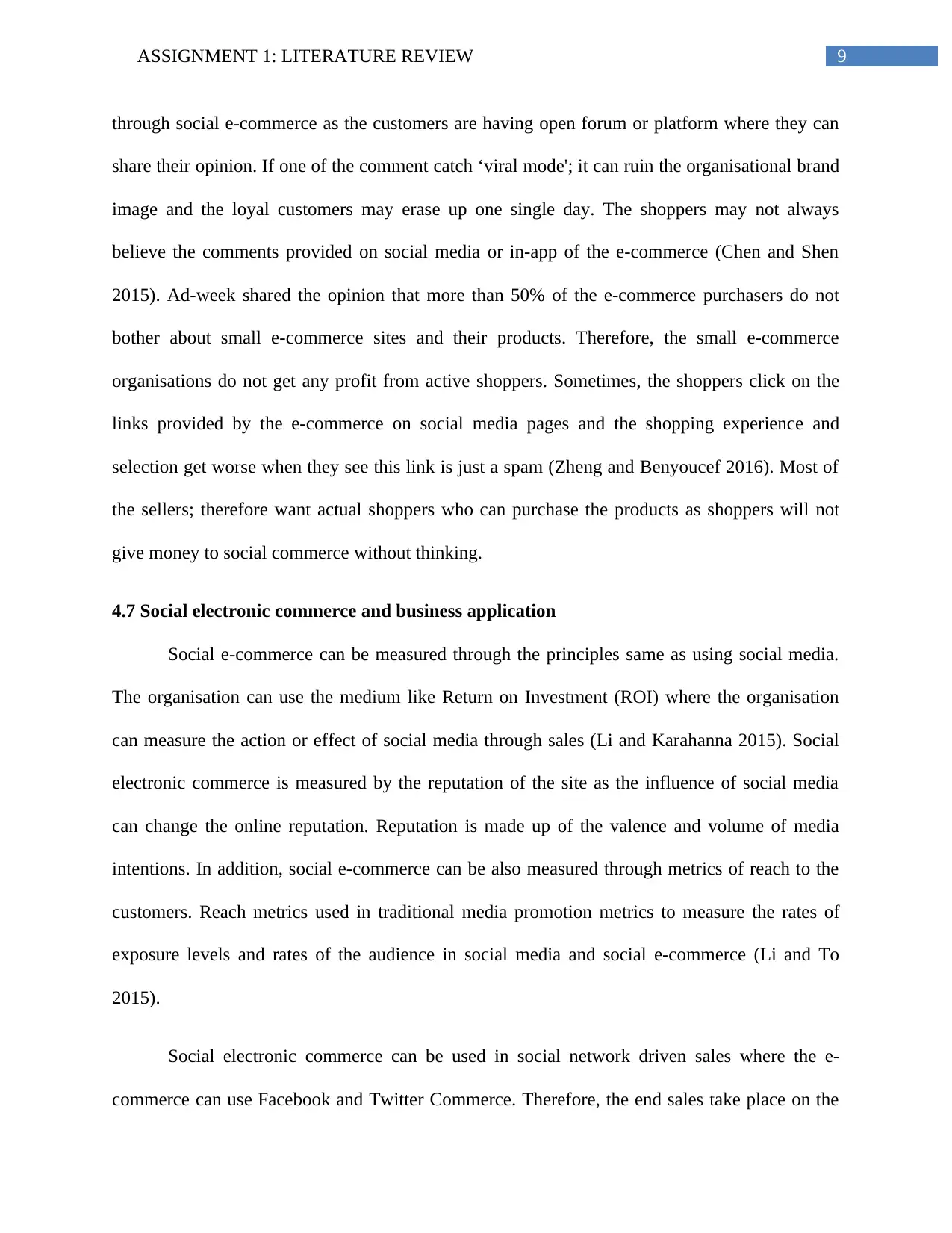
9ASSIGNMENT 1: LITERATURE REVIEW
through social e-commerce as the customers are having open forum or platform where they can
share their opinion. If one of the comment catch ‘viral mode'; it can ruin the organisational brand
image and the loyal customers may erase up one single day. The shoppers may not always
believe the comments provided on social media or in-app of the e-commerce (Chen and Shen
2015). Ad-week shared the opinion that more than 50% of the e-commerce purchasers do not
bother about small e-commerce sites and their products. Therefore, the small e-commerce
organisations do not get any profit from active shoppers. Sometimes, the shoppers click on the
links provided by the e-commerce on social media pages and the shopping experience and
selection get worse when they see this link is just a spam (Zheng and Benyoucef 2016). Most of
the sellers; therefore want actual shoppers who can purchase the products as shoppers will not
give money to social commerce without thinking.
4.7 Social electronic commerce and business application
Social e-commerce can be measured through the principles same as using social media.
The organisation can use the medium like Return on Investment (ROI) where the organisation
can measure the action or effect of social media through sales (Li and Karahanna 2015). Social
electronic commerce is measured by the reputation of the site as the influence of social media
can change the online reputation. Reputation is made up of the valence and volume of media
intentions. In addition, social e-commerce can be also measured through metrics of reach to the
customers. Reach metrics used in traditional media promotion metrics to measure the rates of
exposure levels and rates of the audience in social media and social e-commerce (Li and To
2015).
Social electronic commerce can be used in social network driven sales where the e-
commerce can use Facebook and Twitter Commerce. Therefore, the end sales take place on the
through social e-commerce as the customers are having open forum or platform where they can
share their opinion. If one of the comment catch ‘viral mode'; it can ruin the organisational brand
image and the loyal customers may erase up one single day. The shoppers may not always
believe the comments provided on social media or in-app of the e-commerce (Chen and Shen
2015). Ad-week shared the opinion that more than 50% of the e-commerce purchasers do not
bother about small e-commerce sites and their products. Therefore, the small e-commerce
organisations do not get any profit from active shoppers. Sometimes, the shoppers click on the
links provided by the e-commerce on social media pages and the shopping experience and
selection get worse when they see this link is just a spam (Zheng and Benyoucef 2016). Most of
the sellers; therefore want actual shoppers who can purchase the products as shoppers will not
give money to social commerce without thinking.
4.7 Social electronic commerce and business application
Social e-commerce can be measured through the principles same as using social media.
The organisation can use the medium like Return on Investment (ROI) where the organisation
can measure the action or effect of social media through sales (Li and Karahanna 2015). Social
electronic commerce is measured by the reputation of the site as the influence of social media
can change the online reputation. Reputation is made up of the valence and volume of media
intentions. In addition, social e-commerce can be also measured through metrics of reach to the
customers. Reach metrics used in traditional media promotion metrics to measure the rates of
exposure levels and rates of the audience in social media and social e-commerce (Li and To
2015).
Social electronic commerce can be used in social network driven sales where the e-
commerce can use Facebook and Twitter Commerce. Therefore, the end sales take place on the
Paraphrase This Document
Need a fresh take? Get an instant paraphrase of this document with our AI Paraphraser
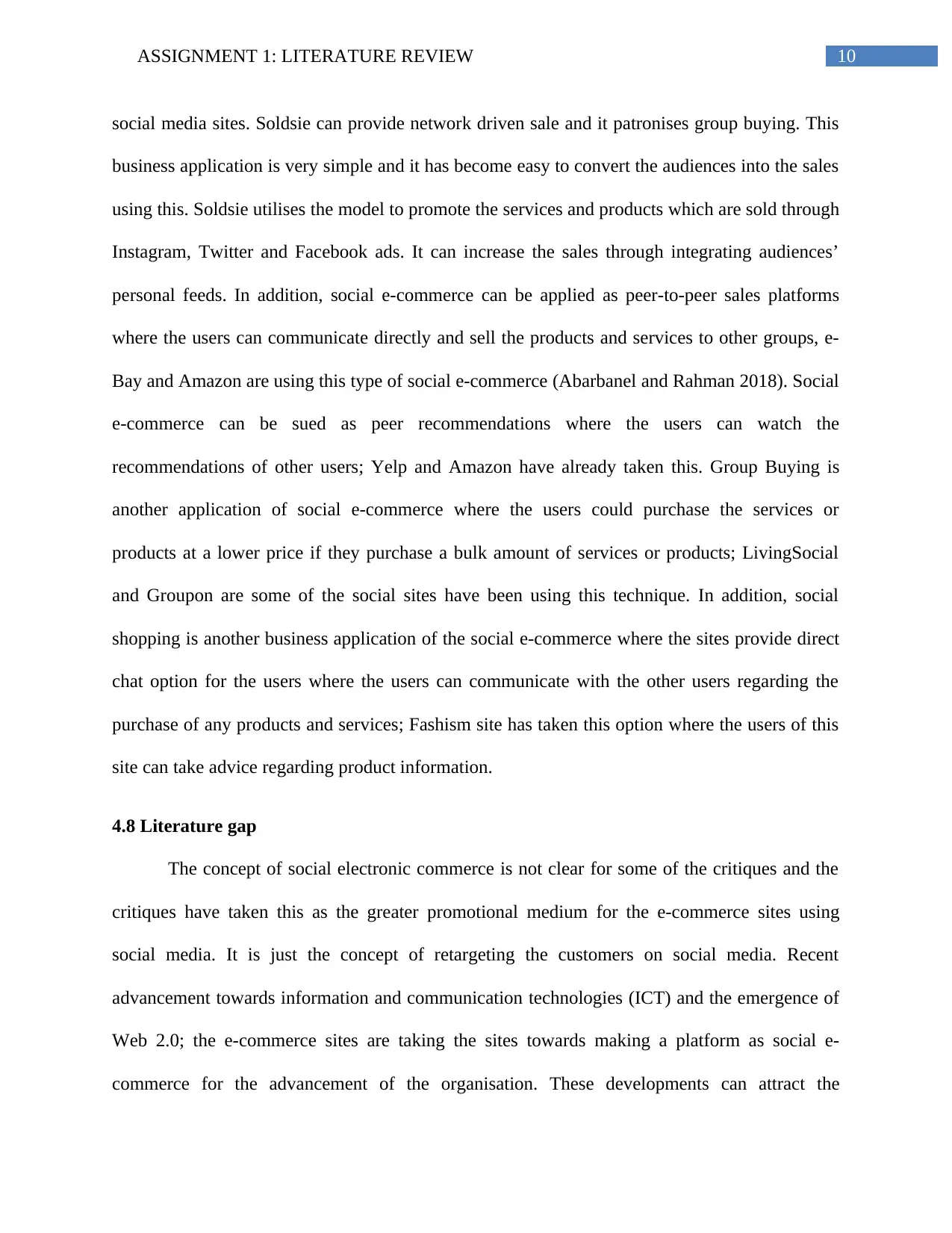
10ASSIGNMENT 1: LITERATURE REVIEW
social media sites. Soldsie can provide network driven sale and it patronises group buying. This
business application is very simple and it has become easy to convert the audiences into the sales
using this. Soldsie utilises the model to promote the services and products which are sold through
Instagram, Twitter and Facebook ads. It can increase the sales through integrating audiences’
personal feeds. In addition, social e-commerce can be applied as peer-to-peer sales platforms
where the users can communicate directly and sell the products and services to other groups, e-
Bay and Amazon are using this type of social e-commerce (Abarbanel and Rahman 2018). Social
e-commerce can be sued as peer recommendations where the users can watch the
recommendations of other users; Yelp and Amazon have already taken this. Group Buying is
another application of social e-commerce where the users could purchase the services or
products at a lower price if they purchase a bulk amount of services or products; LivingSocial
and Groupon are some of the social sites have been using this technique. In addition, social
shopping is another business application of the social e-commerce where the sites provide direct
chat option for the users where the users can communicate with the other users regarding the
purchase of any products and services; Fashism site has taken this option where the users of this
site can take advice regarding product information.
4.8 Literature gap
The concept of social electronic commerce is not clear for some of the critiques and the
critiques have taken this as the greater promotional medium for the e-commerce sites using
social media. It is just the concept of retargeting the customers on social media. Recent
advancement towards information and communication technologies (ICT) and the emergence of
Web 2.0; the e-commerce sites are taking the sites towards making a platform as social e-
commerce for the advancement of the organisation. These developments can attract the
social media sites. Soldsie can provide network driven sale and it patronises group buying. This
business application is very simple and it has become easy to convert the audiences into the sales
using this. Soldsie utilises the model to promote the services and products which are sold through
Instagram, Twitter and Facebook ads. It can increase the sales through integrating audiences’
personal feeds. In addition, social e-commerce can be applied as peer-to-peer sales platforms
where the users can communicate directly and sell the products and services to other groups, e-
Bay and Amazon are using this type of social e-commerce (Abarbanel and Rahman 2018). Social
e-commerce can be sued as peer recommendations where the users can watch the
recommendations of other users; Yelp and Amazon have already taken this. Group Buying is
another application of social e-commerce where the users could purchase the services or
products at a lower price if they purchase a bulk amount of services or products; LivingSocial
and Groupon are some of the social sites have been using this technique. In addition, social
shopping is another business application of the social e-commerce where the sites provide direct
chat option for the users where the users can communicate with the other users regarding the
purchase of any products and services; Fashism site has taken this option where the users of this
site can take advice regarding product information.
4.8 Literature gap
The concept of social electronic commerce is not clear for some of the critiques and the
critiques have taken this as the greater promotional medium for the e-commerce sites using
social media. It is just the concept of retargeting the customers on social media. Recent
advancement towards information and communication technologies (ICT) and the emergence of
Web 2.0; the e-commerce sites are taking the sites towards making a platform as social e-
commerce for the advancement of the organisation. These developments can attract the
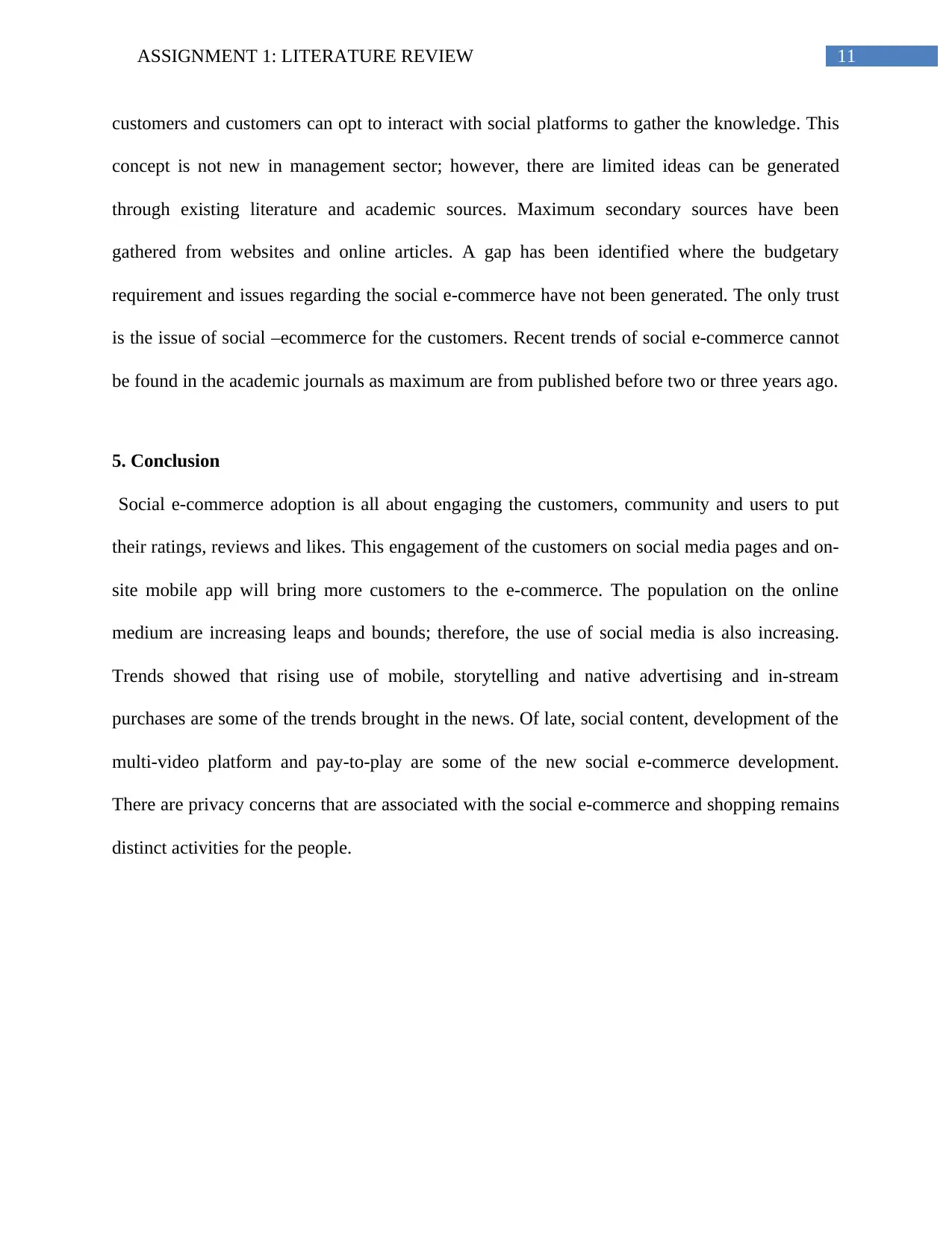
11ASSIGNMENT 1: LITERATURE REVIEW
customers and customers can opt to interact with social platforms to gather the knowledge. This
concept is not new in management sector; however, there are limited ideas can be generated
through existing literature and academic sources. Maximum secondary sources have been
gathered from websites and online articles. A gap has been identified where the budgetary
requirement and issues regarding the social e-commerce have not been generated. The only trust
is the issue of social –ecommerce for the customers. Recent trends of social e-commerce cannot
be found in the academic journals as maximum are from published before two or three years ago.
5. Conclusion
Social e-commerce adoption is all about engaging the customers, community and users to put
their ratings, reviews and likes. This engagement of the customers on social media pages and on-
site mobile app will bring more customers to the e-commerce. The population on the online
medium are increasing leaps and bounds; therefore, the use of social media is also increasing.
Trends showed that rising use of mobile, storytelling and native advertising and in-stream
purchases are some of the trends brought in the news. Of late, social content, development of the
multi-video platform and pay-to-play are some of the new social e-commerce development.
There are privacy concerns that are associated with the social e-commerce and shopping remains
distinct activities for the people.
customers and customers can opt to interact with social platforms to gather the knowledge. This
concept is not new in management sector; however, there are limited ideas can be generated
through existing literature and academic sources. Maximum secondary sources have been
gathered from websites and online articles. A gap has been identified where the budgetary
requirement and issues regarding the social e-commerce have not been generated. The only trust
is the issue of social –ecommerce for the customers. Recent trends of social e-commerce cannot
be found in the academic journals as maximum are from published before two or three years ago.
5. Conclusion
Social e-commerce adoption is all about engaging the customers, community and users to put
their ratings, reviews and likes. This engagement of the customers on social media pages and on-
site mobile app will bring more customers to the e-commerce. The population on the online
medium are increasing leaps and bounds; therefore, the use of social media is also increasing.
Trends showed that rising use of mobile, storytelling and native advertising and in-stream
purchases are some of the trends brought in the news. Of late, social content, development of the
multi-video platform and pay-to-play are some of the new social e-commerce development.
There are privacy concerns that are associated with the social e-commerce and shopping remains
distinct activities for the people.
⊘ This is a preview!⊘
Do you want full access?
Subscribe today to unlock all pages.

Trusted by 1+ million students worldwide
1 out of 15
Related Documents
Your All-in-One AI-Powered Toolkit for Academic Success.
+13062052269
info@desklib.com
Available 24*7 on WhatsApp / Email
![[object Object]](/_next/static/media/star-bottom.7253800d.svg)
Unlock your academic potential
Copyright © 2020–2025 A2Z Services. All Rights Reserved. Developed and managed by ZUCOL.





